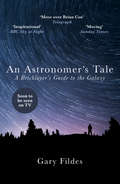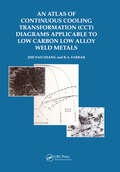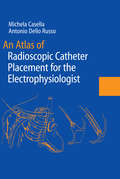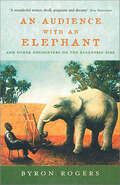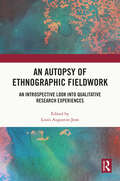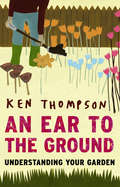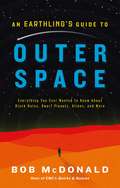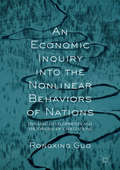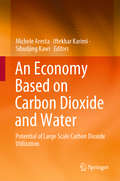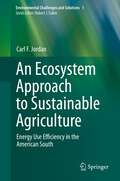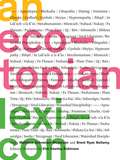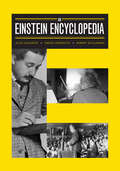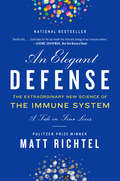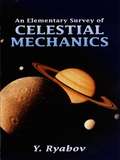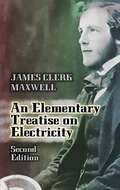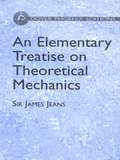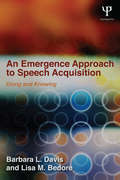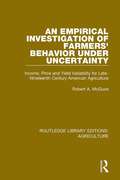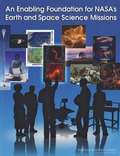- Table View
- List View
An Astronaut's Guide to Life on Earth: What Going To Space Taught Me About Ingenuity, Determination, And Being Prepared For Anything
by Chris HadfieldAs Commander of the International Space Station, Chris Hadfield captivated the world with stunning photos and commentary from space. Now, in his first book, Chris offers readers extraordinary stories from his life as an astronaut, and shows how to make the impossible a reality. Chris Hadfield decided to become an astronaut after watching the Apollo moon landing with his family on Stag Island, Ontario, when he was nine years old, and it was impossible for Canadians to be astronauts. In 2013, he served as Commander of the International Space Station orbiting the Earth during a five-month mission. Fulfilling this lifelong dream required intense focus, natural ability and a singular commitment to &“thinking like an astronaut.&” In An Astronaut&’s Guide to Life on Earth, Chris gives us a rare insider&’s perspective on just what that kind of thinking involves, and how earthbound humans can use it to achieve success and happiness in their lives.Astronaut training turns popular wisdom about how to be successful on its head. Instead of visualizing victory, astronauts prepare for the worst; always sweat the small stuff; and do care what others think. Chris shows how this unique education comes into play with dramatic anecdotes about going blind during a spacewalk, getting rid of a live snake while piloting a plane, and docking with space station Mir when laser tracking systems fail at the critical moment. Along the way, he shares exhilarating experiences, and challenges, from his 144 days on the ISS, and provides an unforgettable answer to his most-asked question: What&’s it really like in outer space?Written with humour, humility and a profound optimism for the future of space exploration, An Astronaut&’s Guide to Life on Earth offers readers not just the inspiring story of one man&’s journey to the ISS, but the opportunity to step into his space-boots and think like an astronaut—and renew their commitment to pursuing their own dreams, big or small.
An Astronomer's Tale: A Bricklayer’s Guide to the Galaxy
by Gary FildesA Bricklayer's Guide to the Galaxy . . . The inspirational memoir of a former brickie who followed his passion for the stars and built his own observatory. Perfect for readers of Robert Macfarlane, Helen Macdonald and James Rebanks - as well as fans of Brian Cox and the BBC’s Sky at Night Gary Fildes left school at sixteen, got a trade like most of his mates and was soon married with four kids. His life seemed set. But he had a secret. Something he only practised late at night with a few like-minded friends. Then one day, middle age approaching alarmingly, he acted on his lifelong passion. He finally came out. As an astronomer.Today, Gary is the founder and lead astronomer of Kielder Observatory, one of the top ten stargazing sites in the world, which he also helped to build. Situated in the beautiful forests of Kielder, Northumberland, within Europe’s largest protected dark sky park, it offers some of the UK's most spectacular views of stars, planets and galaxies.An Astronomer’s Tale is Gary’s inspirational story: part memoir, part nature writing, part seasonal guide to the night sky. It is a book brimming with passion; and at a time when the world is captivated by space, it will leave you ready to get out there and explore the wonders of the skies for yourself.
An Atlas for Staging Mammalian and Chick Embryos
by H. ButlerFor the convenience of research workers, particularly those with limited knowledge of embryology, we have put together a series of tables to enable rapid identification of specific stages of embryonic development in the more commonly used mammals. Because if its frequent usage the chick embryo is included this atlas.
An Atlas of Cat Anatomy
by Hazel E. Field Mary E. TaylorAn Atlas of Cat Anatomy can help a student learn twice as much as he could in the same amount of time using only a written description. The book is spiral bound and stands like an easel, taking a minimum amount of space in the work area. Altogether there are fifty-seven plates featuring the various parts and organ systems in their actual size, making identification remarkably easy. A brief verbal description accompanies each plate. In addition, the extensive glossary includes synonymous terms, derivations, definitions, and keys to pronunciation.
An Atlas of Continuous Cooling Transformation (CCT) Diagrams Applicable to Low Carbon Low Alloy Weld Metals
by Zhuyo ZhangThis atlas is a collection of continuous cooling transformation diagrams applicable to low carbon low alloy weld metals. It will be of assistance to welding engineers, welding metallurgists, welding-consumables designers in industry.
An Atlas of Radioscopic Catheter Placement for the Electrophysiologist
by Andrea Natale Michela Casella Antonio Dello Russo P. Della BellaAn Atlas of Radioscopic Catheter Placement is unique, and has been conceived as a handy reference guide for students, interventional cardiologists, nurses and electrophysiology technicians. It includes plenty of schemes and X-ray images, and every EP correct catheter positioning is explained step by step through detailed descriptions of the necessary manoeuvres, including some "trucks" brought about by the experience.
An Atlas of Selected Galaxies: With Illustrations of Photometric Analyses
by Bunshiro Takase Keiichi Kodaira Sadanori OkamuraIt is only several decades since galaxies were recognized as huge aggregations of matter in the universe which consist of myriads of stars and vast clouds of gas. The wide variety of shapes of galaxies is one of the wonders of the universe. Attempts to classify galaxies have continued since an early stage of study, when they were still called nebulae. The first step towards classification was a grouping of the patterns; the second step a systematic arrangement of various morphological types. Classification schemes that are in present use, such as Hubble's, are in the second group. These classifications are usually based on pattern recognition after a visual inspection of the photographic image of the galaxy, and is therefore qualitative and more or less subjective. Using surface photometry of galaxies, a technique which has advanced remarkably in recent years, photographs of galaxies taken in several colour bands can now be efficiently reduced to photometric data. Analysis of this data gives quantitative information on the luminosity and colour distribution for every element of galaxies. The Atlas of Selected Galaxies presents photographs taken with the Okayama 188 cm reflector and the Kiso 105 cm Schmidt telescope for the purpose of photometric analysis. A large number of illustration are given to demonstrate the way in which photographs of galaxies are reduced into quantitative data. These illustrations also show some representative results obtained in the course of the editors' work on the quantitative classification of galaxies. Part I, General Description of the Classification and Photometric Analyses, includes eight sections, whose authors all shared the photometric work and prepared the photographs. In Part II, The Atlas, the illustrations are arranged in sections corresponding to those in Part I. Part III includes tables of data for the atlas.
An Audience with an Elephant: And Other Encounters on the Eccentric Side
by Byron RogersAn Audience with an Elephant is a compendium of the oddest and most eccentric travels—a travel book to set alongside Norman Lewis and Eric Newby for the sheer unpredictability of its encounters and its surreal comedy. But Bryon Rogers didn&’t venture to the ends of the earth to find singular custom and heroic idiosyncrasy: he had no need to. These are journeys to the heart of the strange and distant land of Britain. On his travels he meets the Turkish POW in British hands—an ancient tortoise captured at Gallipoli and now resident in Great Yarmouth—and the teenaged elephant who has opened more fetes and supermarkets than any TV celebrity. Here, too, are such bizarre figures as the octogenarian triathlete, the man who (before such things were banned) held every world eating record, and the last hangman in his untroubled retirement. Whether exploring the middle of England in the forgotten county of Northamptonshire or accompanying the last tramp through the wilder reaches of Wales, Byron Rogers chronicles a secret history of Britain that is touching, hilarious, magical and the extraordinary lives or ordinary people.
An Autopsy of Ethnographic Fieldwork: An Introspective Look into Qualitative Research Experiences
by Louis Augustin-JeanThis edited volume presents an international collection of fieldwork experiences from every stage of the research process with a view to normalising the process of adaptation, modification, and even failure during fieldwork when circumstances interrupt the expected outcomes.This book aims to address a gap often found in methodology books by including nine full autopsy-like reflection of fieldwork experiences, selected based on researchers’ disciplines and fields, the diversity of geographical locations and their differing themes. Its chapters record a swath of experience, from choosing the research themes and hypotheses through to academic presentations and publications, shedding light on an area academic research that is often overlooked.Documenting experience from anthropologists and sociologists to political scientists and economists, the diversity of the book’s approach and its multidisciplinary focus will interest researchers, scholars, and postgraduate students from a range of subdisciplines and levels of fieldwork experience.
An Ear to the Ground: Understanding Your Garden
by Ken ThompsonHow did plants get to be the way they are? Why do they have pretty flowers? How different would things have been if the wrong kind of pollinators had got the upper hand? Why are Latin names so complicated, and why Latin anyway? Why is a weed-free lawn an ecological impossibility?This entertaining book gives the answers to these questions and many more. It shows how a little botanical knowledge can bring not just better results but peace of mind, and that losing sleep over such traditional gardening bogeys as weeds, pests and pruning is not necessarily the best course. In this new edition Ken Thompson grabs the opportunity to explain why any old plant will do for companion planting - but also that it can do as much harm as good - and why planting by the moon is complete and utter nonsense.
An Earthling's Guide to Outer Space: Everything You Ever Wanted to Know About Black Holes, Dwarf Planets, Aliens, and More
by Bob McDonaldBeloved science commentator Bob McDonald takes us on a tour of our galaxy, unraveling the mysteries of the universe and helping us navigate our place among the stars.How big is our galaxy? Is there life on those distant planets? Are we really made of star dust? And where do stars even come from? In An Earthling’s Guide to Outer Space, we finally have the answers to all those questions and more. With clarity, wisdom, and a great deal of enthusiasm, McDonald explores the curiosities of the big blue planet we call home as well as our galactic neighbours—from Martian caves to storm clouds on Jupiter to the nebulae at the far end of the universe. So if you’re pondering how to become an astronaut, or what dark matter really is, or how an asteroid wiped out the dinosaurs, look no further. Through a captivating mix of stories, experiments, and illustrations, McDonald walks us through space exploration past and present, and reveals what we can look forward to in the future. An Earthling’s Guide to Outer Space is sure to satisfy science readers of all ages, and to remind us earthbound terrestrials just how special our place in the universe truly is.
An Economic Inquiry into the Nonlinear Behaviors of Nations: Dynamic Developments and the Origins of Civilizations
by Rongxing GuoThis book applies an economic approach to examine the driving forces behind the dynamic behaviors of developing nations. Taking into account initial conditions and environmental and external factors often oversimplified by historians and anthropologists, Guo finds that the rise and fall of civilizations and nations followed an anti-Darwinian process: physical weakness, rather than strength, induced humans to adapt. Cultures facing unfavorable physical and environmental conditions developed complex societies to overcome these challenges, while favorable conditions did not incentivize major economic and cultural change. Over centuries of economic growth and development, nations and civilizations' adaptive behaviors have followed a cyclical path at both the country level and in an international context. This interdisciplinary book incorporates elements of history, anthropology, and development into an astute economic analysis that changes the way we think about the origins and evolutions of civilizations.
An Economy Based on Carbon Dioxide and Water: Potential of Large Scale Carbon Dioxide Utilization
by Michele Aresta Iftekhar Karimi Sibudjing KawiThis book is devoted to CO2 capture and utilization (CCU) from a green, biotechnological and economic perspective, and presents the potential of, and the bottlenecks and breakthroughs in converting a stable molecule such as CO2 into specialty chemicals and materials or energy-rich compounds. The use of renewable energy (solar, wind, geothermal, hydro) and non-fossil hydrogen is a must for converting large volumes of CO2 into energy products, and as such, the authors explore and compare the availability of hydrogen from water using these sources with that using oil or methane. Divided into 13 chapters, the book offers an analysis of the conditions under which CO2 utilization is possible, and discusses CO2 capture from concentrated sources and the atmosphere. It also analyzes the technological (non-chemical) uses of CO2, carbonation of basic minerals and industrial sludge, and the microbial-catalytic-electrochemical-photoelectrochemical-plasma conversion of CO2 into chemicals and energy products. Further, the book provides examples of advanced bioelectrochemical syntheses and RuBisCO engineering, as well as a techno-energetic and economic analysis of CCU. Written by leading international experts, this book offers a unique perspective on the potential of the various technologies discussed, and a vision for a sustainable future. Intended for graduates with a good understanding of chemistry, catalysis, biotechnology, electrochemistry and photochemistry, it particularly appeals to researchers (in academia and industry) and university teachers.
An Ecosystem Approach to Sustainable Agriculture: Energy Use Efficiency in the American South (Environmental Challenges and Solutions #1)
by Carl F. JordanModern industrial agriculture is not sustainable because of its heavy reliance on petroleum, a non-renewable source of the energy used in farming, and because of pollution caused by petroleum products such as fertilizers and pesticides. A systems analysis of farming suggests that agriculture will be more sustainable when services of nature, such as nutrient recycling by soil micro-organisms and natural controls of insects, replace the services now provided by energy from petroleum. Examples are drawn from the Southeastern USA, but lessons learned can be applied worldwide.
An Ecotopian Lexicon
by Kim Stanley Robinson Karen O'Brien David N. Pellow Kari Marie Norgaard Randall Amster Daniel Worden Rebecca Evans Sheena Wilson Anthony Lioi Andrew Pendakis Sam Solnick Brent Ryan Bellamy Melody Jue Andrew Alan Johnson Yifei Li Carolyn Fornoff Evelyn O'Malley Sofia Ahlberg Malcolm Sen Chris Pak Allison Ford Jennifer Lee Johnson Michael Horka Ann Kristin Schorre John Esposito Kira Bre Clingen Miraim Tola Charis Boke Pierre-Héli Monot Andrew Hageman Janet Tamalik McGrath Kimberly Skye Richards Robert Savino Oventile Cherice BockPresents thirty novel terms that do not yet exist in English to envision ways of responding to the environmental challenges of our generation As the scale and gravity of climate change becomes undeniable, a cultural revolution must ultimately match progress in the realms of policy, infrastructure, and technology. Proceeding from the notion that dominant Western cultures lack the terms and concepts to describe or respond to our environmental crisis, An Ecotopian Lexicon is a collaborative volume of short, engaging essays that offer ecologically productive terms—drawn from other languages, science fiction, and subcultures of resistance—to envision and inspire responses and alternatives to fossil-fueled neoliberal capitalism. Each of the thirty suggested &“loanwords&” helps us imagine how to adapt and even flourish in the face of the socioecological adversity that characterizes the present moment and the future that awaits. From &“Apocalypso&” to &“Qi,&” &“ ~*~ &“ to &“Total Liberation,&” thirty authors from a range of disciplines and backgrounds assemble a grounded yet dizzying lexicon, expanding the limited European and North American conceptual lexicon that many activists, educators, scholars, students, and citizens have inherited. Fourteen artists from eleven countries respond to these chapters with original artwork that illustrates the contours of the possible better worlds and worldviews.Contributors: Sofia Ahlberg, Uppsala U; Randall Amster, Georgetown U; Cherice Bock, Antioch U; Charis Boke, Cornell U; Natasha Bowdoin, Rice U; Kira Bre Clingen, Harvard U; Caledonia Curry (SWOON); Lori Damiano, Pacific Northwest College of Art; Nicolás De Jesús; Jonathan Dyck; John Esposito, Chukyo U; Rebecca Evans, Winston-Salem State U; Allison Ford, U of Oregon; Carolyn Fornoff, U of Illinois at Urbana-Champaign; Michelle Kuen Suet Fung; Andrew Hageman, Luther College; Michael Horka, George Washington U; Yellena James; Andrew Alan Johnson, Princeton U; Jennifer Lee Johnson, Purdue U; Melody Jue, U of California, Santa Barbara; Jenny Kendler; Daehyun Kim (Moonassi); Yifei Li, NYU Shanghai; Nikki Lindt; Anthony Lioi, Juilliard School of New York; Maryanto; Janet Tamalik McGrath; Pierre-Héli Monot, Ludwig Maximilian U of Munich; Kari Marie Norgaard, U of Oregon; Karen O&’Brien, U of Oslo, Norway; Evelyn O&’Malley, U of Exeter; Robert Savino Oventile, Pasadena City College; Chris Pak; David N. Pellow, U of California, Santa Barbara; Andrew Pendakis, Brock U; Kimberly Skye Richards, U of California, Berkeley; Ann Kristin Schorre, U of Oslo, Norway; Malcolm Sen, U of Massachusetts Amherst; Kate Shaw; Sam Solnick, U of Liverpool; Rirkrit Tiravanija, Columbia U; Miriam Tola, Northeastern U; Sheena Wilson, U of Alberta; Daniel Worden, Rochester Institute of Technology.
An Einstein Encyclopedia
by Alice Calaprice Robert Schulmann Daniel KennefickThis is the single most complete guide to Albert Einstein's life and work for students, researchers, and browsers alike. Written by three leading Einstein scholars who draw on their combined wealth of expertise gained during their work on the Collected Papers of Albert Einstein, this authoritative and accessible reference features more than one hundred entries and is divided into three parts covering the personal, scientific, and public spheres of Einstein's life.An Einstein Encyclopedia contains entries on Einstein's birth and death, family and romantic relationships, honors and awards, educational institutions where he studied and worked, citizenships and immigration to America, hobbies and travels, plus the people he befriended and the history of his archives and the Einstein Papers Project. Entries on Einstein's scientific theories provide useful background and context, along with details about his assistants, collaborators, and rivals, as well as physics concepts related to his work. Coverage of Einstein's role in public life includes entries on his Jewish identity, humanitarian and civil rights involvements, political and educational philosophies, religion, and more.Commemorating the hundredth anniversary of the theory of general relativity, An Einstein Encyclopedia also includes a chronology of Einstein's life and appendixes that provide information for further reading and research, including an annotated list of a selection of Einstein's publications and a review of selected books about Einstein.More than 100 entries cover the rich details of Einstein's personal, professional, and public lifeAuthoritative entries explain Einstein's family relationships, scientific achievements, political activities, religious views, and moreMore than 40 illustrations include photos of Einstein and his circle plus archival materialsA chronology of Einstein's life, appendixes, and suggestions for further reading provide essential details for further research
An Elegant Defense: The Extraordinary New Science of the Immune System: A Tale in Four Lives
by Matt RichtelA magnificently reported and soulfully crafted exploration of the human immune system–the key to health and wellness, life and death. An epic, first-of-its-kind book, entwining leading-edge scientific discovery with the intimate stories of four individual lives, by the Pulitzer Prize–winning New York Times journalist.“An Elegant Defense by Matt Richtel is one of those rare nonfiction books that transcends the genre. On one level it is a fascinating and engrossing account of the latest, and quite astonishing, discoveries involving the human immune system and how it works. But it is also a story about people facing mortality, about the passion of scientists searching for truth, and a meditation on death and how all of us struggle with the ultimate mystery. Heartfelt and moving, full of compassion, love, and the human drama, this is the work of a writer of high ethical character who is grappling with big issues and deep humanistic problems. What an inspiring and wonderful read. I highly recommend this extraordinary book.” —DOUGLAS PRESTON, #1 bestselling author of The Lost City of the Monkey God
An Elementary Survey of Celestial Mechanics (Dover Books on Physics)
by G. Yankovsky Y. RyabovAn accessible exposition of gravitation theory and celestial mechanics, this classic, oft-cited work was written by a distinguished Soviet astronomer. It explains with exceptional clarity the methods used by physicists in studying celestial phenomena.A historical introduction explains the Ptolemaic view of planetary motion and its displacement by the studies of Copernicus, Kepler, and Newton. Succeeding chapters examine the making of celestial observations and measurements and explain such central concepts as the ecliptic, the orbital plane, the two- and three-body problems, and perturbed motion. Ryabov also describes how perturbations in the path of Uranus led to the discovery of Neptune, and he devotes considerable attention to satellites, including a detailed treatment of the first artificial satellite, Sputnik I. Additional topics include planetary rotation, the calculation of units of time, and the motions of the stars, with illustrations of how the law of gravity determines the shapes of galaxies. The book concludes with a deeper consideration of gravity, pointing out basic distinctions between classical and Einsteinian theories.
An Elementary Treatise on Electricity: Second Edition (Dover Books on Physics)
by James Clerk MaxwellAlbert Einstein characterized the work of James Clerk Maxwell as the "most profound and the most fruitful that physics has experienced since the time of Newton." Max Planck went even further, declaring that "he achieved greatness unequalled," and Richard Feynman asserted that "From a long view of the history of mankind -- seen from, say, ten thousand years from now -- there can be little doubt that the most significant event of the nineteenth century will be judged as Maxwell's discovery of the laws of electrodynamics." Maxwell made numerous other contributions to the advancement of science, but the greatest work of his life was devoted to electricity. An Elementary Treatise on Electricity appeared at a time when very few books on electrical measurements were available to students, and its compact treatment not only elucidates the theory of electricity but also serves to develop electrical ideas in readers' minds. The author describes experiments that demonstrate the principal facts relating an electric charge as a quantity capable of being measured, deductions from these facts, and the exhibition of electrical phenomena.This volume, published posthumously from Maxwell's lecture notes at the Cavendish Laboratory -- which he founded at the University of Cambridge -- is supplemented by a selection of articles from his landmark book, Electricity and Magnetism. A classic of science, this volume is an eminently suitable text for upper-level undergraduates and graduate students.
An Elementary Treatise on Theoretical Mechanics (Dover Books on Physics)
by Sir James JeansIn addition to being among the twentieth century's major scientific figures, Sir James Jeans (1877-1946) was also one of the greatest modern science expositors. His classic introduction to mechanics endures as a clear and concise presentation of first principles.Although brief, it encompasses a remarkably wide selection of topics. Its subjects include rest and motion, force and the laws of motion, forces acting on a single particle, statics of systems of particles, statics of rigid bodies, center of gravity, work, motion of a particle under constant forces, motion of systems of particles, motion of a particle under a variable force, motion of rigid bodies, and generalized coordinates. Within each chapter, the author carefully explains the most elementary concepts (such as velocity, acceleration, Newton's laws, friction, moments, and kinetic energy), and he illustrates them with examples.Ideal for beginning physics students or for more advanced readers in need of refreshment, the text emphasizes the fundamental physical principles rather than mathematics or applications. So clearly written that it can be read and understood outside the classroom, it features hundreds of fully worked illustrative examples and test exercises.
An Emergence Approach to Speech Acquisition: Doing and Knowing
by Barbara L. Davis Lisa M. BedoreThe central assertion in this volume is that the young child uses general skills, scaffolded by adults, to acquire the complex knowledge of sound patterns and the goal-directed behaviors for communicating ideas through language and producing speech. A child’s acquisition of phonology is seen as a product of her physical and social interaction capacities supported by input from adult models about ambient language sound patterns. Acquisition of phonological knowledge and behavior is a product of this function-oriented complex system. No pre-existing mental knowledge base is necessary for acquiring phonology in this view. Importantly, the child’s diverse abilities are used for many other functions as well as phonological acquisition. Throughout, an evaluation is made of the research on patterns of typical development across languages in monolingual and bilingual children and children with speech impairments affecting various aspects of their developing complex system. Also considered is the status of available theoretical perspectives on phonological acquisition relative to an emergence proposal, and contributions that this perspective could make to more comprehensive modeling of the nature of phonological acquisition are proposed. The volume will be of interest to cognitive psychologists, linguistics, and speech pathologists.
An Empire of Ice: Scott, Shackleton, and the Heroic Age of Antarctic Science (Playaway Adult Nonfiction Ser.)
by Edward J. LarsonA Pulitzer Prize–winning author examines South Pole expeditions, &“wrapping the science in plenty of dangerous drama to keep readers engaged&” (Booklist). An Empire of Ice presents a fascinating new take on Antarctic exploration—placing the famed voyages of Norwegian explorer Roald Amundsen, his British rivals Robert Scott and Ernest Shackleton, and others in a larger scientific, social, and geopolitical context. Recounting the Antarctic expeditions of the early twentieth century, the author reveals the British efforts for what they actually were: massive scientific enterprises in which reaching the South Pole was but a spectacular sideshow. By focusing on the larger purpose of these legendary adventures, Edward J. Larson deepens our appreciation of the explorers&’ achievements, shares little-known stories, and shows what the Heroic Age of Antarctic discovery was really about. &“Rather than recounting the story of the race to the pole chronologically, Larson concentrates on various scientific disciplines (like meteorology, glaciology and paleontology) and elucidates the advances made by the polar explorers . . . Covers a lot of ground—science, politics, history, adventure.&” —The New York Times Book Review
An Empirical Investigation of Farmers Behavior Under Uncertainty: Income, Price and Yield Variability for Late-Nineteenth Century American Agriculture (Routledge Library Editions: Agriculture #12)
by Robert A. McGuireThis study, first published in 1985, aims to provide objective measures of the risks associated with various crops and livestock in the late nineteenth century and to examine two important issues in American economic history. Knowledge of these risks if a necessity to the profession, if analyses of the uncertainties of postbellum agriculture are to continue. Without this knowledge, assertions which have little or no empirical content will continue to be made. This title will be of great interest to students of economics and agriculture.
An Enabling Foundation for NASA'S Earth and Space Science Missions
by National Research Council of the National AcademiesNASA's space and Earth science program is composed of two principal components: spaceflight projects and mission-enabling activities. Most of the budget of NASA's Science Mission Directorate (SMD) is applied to spaceflight missions, but NASA identifies nearly one quarter of the SMD budget as "mission enabling." The principal mission-enabling activities, which traditionally encompass much of NASA's research and analysis (R&A) programs, include support for basic research, theory, modeling, and data analysis; suborbital payloads and flights and complementary ground-based programs; advanced technology development; and advanced mission and instrumentation concept studies. While the R&A program is essential to the development and support of NASA's diverse set of space and Earth science missions, defining and articulating an appropriate scale for mission-enabling activities have posed a challenge throughout NASA's history. This volume identifies the appropriate roles for mission-enabling activities and metrics for assessing their effectiveness. Furthermore, the book evaluates how, from a strategic perspective, decisions should be made about balance between mission-related and mission-enabling elements of the overall program as well as balance between various elements within the mission-enabling component. Collectively, these efforts will help SMD to make a good program even better.
An Encyclopedia of Small Fruit
by Robert E GoughAn A-to-Z look at the world of small fruits While there are many books on small fruit culture, their focus is often very specific or confined to just a few species. Packed with useful information, An Encyclopedia of Small Fruit is the comprehensive A-to-Z reference that not only details all temperate and tropical small fruit grown throu

